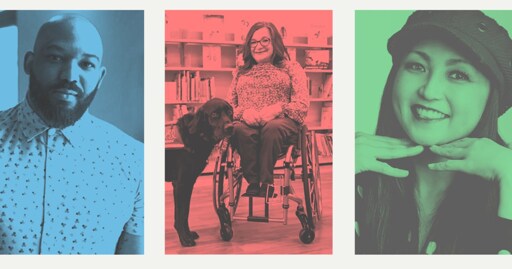It’s a difficult period for disability rights: Landmark legal protections have come under attack by the Trump administration, the right is at war with the Department of Education, Medicaid is being gutted to finance tax cuts for the rich, and the President of the United States openly espouses eugenicist ideas—as do some of his top advisors.
It’s also Disability Pride Month, commemorating in part the July 1990 signing of the Americans With Disabilities Act and lifting up disability culture and visibility—which goes far beyond the right’s blitz against disabled people’s legal, medical, and economic rights.
In celebration of Disability Pride Month, Iinterviewed three disabled Americans about what brings them joy and hope in a challenging time: Kara Ayers, an assistant professor in pediatrics at the University of Cincinnati; AJ Link, the director of policy at New Disabled South; and dancer and advocate Marisa Hamamoto, founder of Infinite Flow Dance.
 Kara Ayers, associate director of the University of Cincinnati Center for Excellence in Developmental DisabilitiesCourtesy of Kara Ayers
Kara Ayers, associate director of the University of Cincinnati Center for Excellence in Developmental DisabilitiesCourtesy of Kara Ayers
Kara Ayers
Ayers, who has osteogenesis imperfecta, says teaching her kids about disability history and culture brings her joy.
For our family, which is led by my husband and me—we’re both full-time wheelchair users and we’re both little people—it was important to us that we get out in front of the narrative that society would teach our kids about disability. We wanted them to be taught about disability by us, in our home, and through our connections to the disability community. So we’ve taught them about disability figures that have contributed to history, whether to disability rights or just to history, because I think that’s an important lesson—that disabled people don’t only contribute to disabled things or rights.
My husband and I both have forms of dwarfism and identify as little people, and our son, who’s the oldest of three, has achondroplasia, which is the most common form of dwarfism. He’s been especially interested in figures in history with dwarfism, as have his sisters. We’ve talked about Benjamin Lay, an abolitionist, who was a little person. Sometimes, people put an artificial threshold on how big or well-known a person needs to be [in order to be] a historical figure, and I think that maybe holds us back sometimes. They know Rebecca Cokley, who’s a little person who worked in the Obama White House, or Greta Thunberg—we’ve looked at how she can command an audience, [the] big crowds she’s spoken to.
We like to read perspectives from people who have ideas around your body [being] your body—[that] people don’t have the right to touch it without your consent or ask you for personal information without your consent. With my eight-year-old daughter, I don’t use the word eugenics, but we’ve talked honestly and openly about the idea that some people think that people with disabilities should not be parents.
I really like seeing my son’s excitement and pride develop as both as a little person, and that he also openly and proudly identifies as somebody with ADHD and learns about historical figures who likely had what we now call ADHD or neurodivergence. It’s really cool to see him as a young person figuring out who he is and realizing that there have always been disabled people contributing to history, and just to see him integrate that into who he is.
 “Space law has taught me that there are lots of avenues for a special interest,” says AJ Link.Courtesy of AJ Link
“Space law has taught me that there are lots of avenues for a special interest,” says AJ Link.Courtesy of AJ Link
AJ Link
Link, who is autistic, works at the nonprofit New Disabled South and teaches space law—which he says brings him joy—at Howard University in Washington, DC; he is one of the co-founders of the Palestine Space Institute and a member of the board of Black in Astro, among other organizations.
I’m someone who’s always loved space. Wanted to be an astronaut, watched all the nerdy space things—and I couldn’t do space in that way. I wanted to be an astrophysicist, and that didn’t work out. I wanted to be an astronaut, that didn’t work out. So having an opportunity to get to be part of the space community and do space work was something that was really appealing. I was happy that there was this opportunity that I didn’t even know existed.
I’m really drawn to space law because of the opportunity—thinking about the future of space law and governance is a way for us to reflect on some of the flaws of how we govern ourselves now, on Earth; how we construct our governments and governance structures. Space law is a tool and potentially a mirror, where we think about designing new systems, learning from the flaws of our current systems, and hopefully making those new systems better.
Hope is there because the systems aren’t as entrenched. Humanity doesn’t live on the moon yet. Humanity doesn’t live on Mars. Humanity doesn’t permanently live in space. There’s still hope that we can change the future.
We always need more people who have different perspectives than the traditional entrance perspectives of space capitalism, space militarism, and space surveillance. I think having people who love and care about space, and [envision] a different future for space than people like Elon Musk, is really important to fight those [interests].
Military companies and weapons manufacturers who are traditionally space companies, or traditionally operate in the space sector, are the ones who are building the bombs and the technology to kill Palestinians in Gaza, but also the surveillance technology in the West Bank. So when you think about companies like Boeing or Lockheed, they’re major players in the defense industry, but also major players in the space industry, because the defense industry in the space industry have been tied since the beginning. And when you think about the surveillance technology, that the Israel Defense Forces use in order to select their targets. All of those are operating within the realm of space and space activity, and so those technologies are used to [facilitate the] genocide of Palestinians.
Space law has taught me that there are lots of avenues for a special interest. We don’t always know that there are different ways that we can be involved with the things we love most and care about the most, beyond just traditional pathways.
 Marisa Hamamoto’s Infinite Flow Dance company includes both disabled and non-disabled dancers.Samantha Tokita
Marisa Hamamoto’s Infinite Flow Dance company includes both disabled and non-disabled dancers.Samantha Tokita
Marisa Hamamoto
Hamamoto is a spinal stroke survivor who is autistic, and the founder of Infinite Flow Dance, a dance company and nonprofit based in Southern California.
I grew up in Irvine, California, during the ’80s and ’90s. Irvine, at that time, was a predominantly white city, so my family, being Japanese American, was a minority. I got picked on at school for looking different, and I quickly learned that our differences can divide us. My happy place was a weekly ballet class after school, where, even though I was the only dancer of color, moving my body to music made me feel like I belonged.
During my teenage years, I aspired to become a professional ballerina, but I was constantly told that my body wasn’t right for dance, and that included my ethnicity as an Asian American. I started to live in this duality where I knew in my gut that dance is a universal language that belongs to everyone—yet the world was saying that dance was only accessible to a few. I never made it as a ballerina, but I didn’t give up on my career. During my college years in Japan, when I went to Keio University in Tokyo, I was pursuing a dance career outside of school.
In 2006, I was a senior college student taking a contemporary dance class late at night off campus, and I was having a really good dance day. I felt my elbows tingle and momentarily fell to the ground. My arms couldn’t move. My legs. I found myself completely paralyzed from the neck down. I was carried to the hospital, diagnosed with spinal cord infarction, also known as a spinal stroke, and was told by the doctor that I may never be able to walk or dance again. And in that moment, I really thought that this was kind of the end of my life, because to me at that time, dance was everything, and what was there to life without dance? I kind of miraculously walked out of the hospital a couple of months later. I was really scared to dance because the stroke had kind of triggered a lot of trauma. There was also a fear that if I went and took a dance class again, the stroke might happen again.
So this one thing, dance, that brought me so much joy and so much happiness, suddenly became something that I feared to do. For about three and a half years, I didn’t really dance. I was scared to dance, and I was scared to live. I feared that the stroke was going to happen again, and I had also socially isolated myself.
About three and a half years after the stroke, there was a holiday business party I attended in the middle of Tokyo. In the middle of this corporate party was a salsa dance performance. Afterward, they called everybody onto the dance floor and taught us this basic salsa step. Us Japanese people are pretty reserved in general, but I’ll tell you that I had never seen so many Japanese people just light up. Whether they were doing the salsa step correctly or incorrectly, it didn’t matter. Everybody was just having fun.
I was in the middle of that, having my own fun—and as I was stepping that basic salsa step, that was when I was brought back into my body, and that was when I realized that my life mattered, and it wasn’t my time to go yet. Dance is for fun, for joy, for expression, for freedom. It was all of that. The moment I had made a decision to aspire to become a professional ballerina, I kind of lost the joy of dance. Then I had a stroke that literally stopped me from dancing. I thought my dance career was over. But in that Tokyo holiday party, I was brought back to the joy of dance and love of dance as well.
From Mother Jones via this RSS feed


